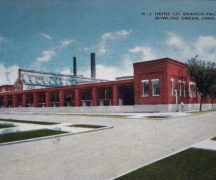By JAN LARSON McLAUGHLIN
BG Independent News
Bowling Green residents may soon be told to “take a hike” through historic areas of the city.
The city’s Historic Preservation Commission met Tuesday to continue efforts to save historically significant structures in Bowling Green. To do that, the commission members believe city residents must first buy into the program.
So the goal is to revive historic walking tours of the city this summer, and offer workshops this fall to help residents research the history of their houses.
Walking tours of the past have taken participants along routes to view significant structures like:
- The building constructed for “dependent and incorrigible children” in 1926.
- The downtown hotel where Ernest Hemingway, Clark Gable, Pretty Boy Floyd and Billy the Killer stayed.
- The first house in the city to have an indoor bathtub.
- The downtown storefront with two cattle heads, built for a local butcher.
- The answers appear at the end of this story.
The commission agreed Tuesday to focus on creating historic preservation districts in the downtown and Boomtown areas of the city.
The Boomtown area, which includes 132 buildings, is bounded by West Wooster, South Church, North Grove, North Maple and Buttonwood streets. Many of the structures there are already on the National Registry of Historic Places.
Most of the homes were built following two major events in Bowling Green which caused a boom in the growth of the town. The first was the final designation of Bowling Green as the county seat of Wood County in 1875. The second was the discovery of oil and natural gas nearby in 1886.
The Boomtown area features architecture styles including Italianate, Queen Anne, Eastlake and Colonial/Georgian Revival styles. Some of the homes feature red tile hip and gable roofs, wraparound verandas, turned posts and spindles, leaded stained glass, and mullion paned windows.
The hope is that by offering tours and workshops, that the historic preservation efforts in the city will gain momentum.
The commission has also set its sights on including four city, county and BGSU buildings on its list of significant sites – the Wood County Courthouse and jail, BGSU University Hall, Bowling Green Police Division, and Needle Hall in City Park.
To get the community involved, the commission members hope to hold a workshop on the inventory process for designating historically significant structures. A “friends” advisory committee may be created, and the BGSU history department may be enlisted to help.
Other ideas suggested that may stir community enthusiasm for historic preservation are:
- Establishing a “historic building of the month” project, with nominations being accepted from the community.
- Creating a brochure of historic areas of the city. Then offering walking tours featuring interesting sites, possibly with historic reenactors guiding the tours.
- Posting markers at historically significant sites, such as the former armory and Heinze plant.
- Hosting a city roundtable with community leaders.
- Offering tips on how to keep historic buildings from deteriorating.
- Holding public hearings each time a new historic preservation district is created.
- Creating a “friends” advisory committee.
- Offering workshops to help people research the history of their homes.
“There are not big expectations,” John Sampen, chair of the Historic Preservation Commission, said of the advisory committee. “We just want to know what people think of our historic push, and how we can make this happen.”
Other members of the HPC are Les Barber, Chris Mowen, Chris Tracy and Wil Roudebush.
(Youth Detention Home at 541 W. Wooster St., Millikin Hotel at the southeast corner of Main and Wooster streets , Newton House at 135 N. Grove St., and the Lehman Building at 116 S. Main St.)


